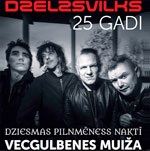Latvian rock band Dzelzs vilks, with their aggressive music and bleak lyrics, has been plying their trade for more than a quarter century. Their songs have a broad range of musical styles, including elements of industrial, punk, and heavy metal music, but also folk and traditional elements. To celebrate their twenty-fifth anniversary, the group released a two CD set of their best songs – Dziesmas pilnmēness naktī – in 2016. The album collects songs from their many popular and acclaimed albums, such as 2003’s Ļauj man tevi, 2004’s Manās mājās sieviešu nav, and 2007’s Sārtā rītausma, among others.
The group, led by vocalist, guitarist and principal songwriter Juris Kaukulis, have achieved enduring popularity in Latvia for their very personal and emotional songs, often about failed and unhappy romantic entanglements, which have resonated with their listeners with their direct and often very explicit lyrics. Kaukulis’ distinct vocal style has been an integral part of their success, and one often hears pain and torment vividly in his vocals. Kaukulis is joined by Kaspars Tobis on synthesizers, drummer Mārcis Judzis and bassist Kārlis Aiviķis (though through most of their history, Armands Butkevičs provided bass).
Dark and foreboding elements are woven throughout their songs, such as ‘Draudzene nakts’, an ode to the approaching night, and, as noted by Kaukulis in the liner notes, the song was inspired in part by a tomcat that passed his window one midnight, and Kaukulis noticed the cat was missing an eye and an ear, and possibly some teeth as well. This dark image adds to the feeling of dread captured in Kaukulis’ vocals and lyrics.
Failed or short-lived relationships are often documented in detail in their songs, such as ‘Tev oranži mati’, ‘Vienas nakts meitene’, and ‘Vēlreiz’, with its cry of despair in lyrics like ‘Man vairs nav tev ko teikt, bet lūdzu ļauj aizmirst tevi’ (I have nothing further to say to you, but please let me forget you). Though deeply personal, the songs do occasionally veer into the territory of self-parody, such as on the silly ‘Dibenā rautais disko’ (a song so vulgar, Judzis requested that the song not be performed at one concert, as his mother was in the audience).
A particularly striking track is ‘Sažņaudz manas rokas’ (from 2009’s Dzelzs vilka teātris), which was the title song for the theatrical production of ‘Tas trakais, trakais Harijs’ (directed by Dž. Dž. Džilindzērs), and featuring vocalist Ilze Ķuzule-Skrastiņa. The song, built on an ominous sliding guitar riff, like many of their songs, expresses sentiments of alienation in lyrics like ‘Enģeļi tevi mīlēt nepratīs’ (Angels will not know how to love you).
Though the group’s history began in 1991, the earliest recording on this collection is 1997’s ‘Ja būtu man spārni’, a song whose rawness is in sharp contrast to their more polished recent recordings. Displaying a more hardcore approach, with heavily distorted guitars and growling, almost death metal-like vocals, the song still contains many elements that are still a part of their music today.
Dzelzs vilks have also dabbled in folk music with memorable results, particularly on their album Uijā uijā nikni vilki, released in 2008, and have collaborated with other folklore ensembles like Forshpil, and even created their own folklore ensemble – the Jauno Jāņu orķestris. This collection does not include any songs from their folk music explorations, which is unfortunate, as these were some of their strongest and most memorable efforts. Perhaps the group wanted to focus on their rock oeuvre on this collection, but leaving out their works in the folk genre disregards a large section of their creative output, and denies many potential new listeners from hearing this material.
Dziesmas pilnmēness naktī is a comprehensive and thorough display of Dzelzs vilks’ quarter century of uncompromising performances. The group has recorded many memorable songs throughout the years, and has shown a remarkable consistency in quality during this time. Though some may find it challenging to listen to songs that are almost uniformly bleak and somber, their words speak to many listeners with their directness and emotional frankness. Maintaining this kind of intensity for so many years is an admirable feat, and, as this collection shows, Dzelzs vilks have built up an impressive and memorable repertoire.
For further information, please visit the Dzelzs vilks website.
Dziesmas pilnmēness naktī
Dzelzs vilks
Upe tuviem un tāliem, UPEtt CD089, 2016
Track listing:
- CD1
- Viņa grib tik daudz
- Tu vilki nakti
- Tev oranži mati
- Skaiti līdz trīs
- Sažņaudz manas rokas
- Mēness
- Draudzene nakts
- Vienas nakts meitene
- Balerina
- Ļauj man tevi
- Bīstami vārdi
- CD2
- Auksto staru gaisma
- Meitene no sirds
- Manās mājās sieviešu nav
- Pret sienu
- Cilpa zem tilta (Miesnieks)
- Vilks
- Vēlreiz
- Dibenā rautais disko
- Dievi krīt
- Rīts
- Ziema
- Ledus
- Klau klau (cik sēri zvani)
- Ja būtu man spārni




